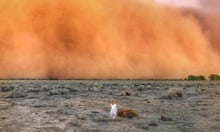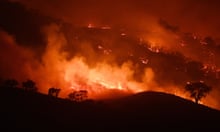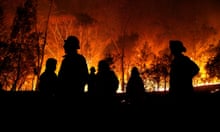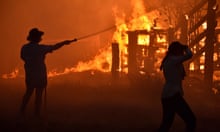It could be months before eastern Australia has more than a million hectares of bushfires under control, the New South Wales fire chief has warned, as the country faces one of its worst bushfire outbreaks.
After relief that no further lives were lost on Tuesday, concern was growing over unpredictable winds worsening fires in the neighbouring state of Queensland on Wednesday, with much hotter temperatures also predicted for the Sydney area in the coming days.
Gusty winds changing direction are predicted to fan flames in new directions and widen “catastrophic” fire fronts in Queensland and northern NSW, where more than 100 fires – one more than 150,000 hectares (370,000 acres) in size – are burning.
Forecasters warned that “dry lightning” strikes could ignite new blazes, with fires worsening when hotter temperatures arrive over the weekend. Temperatures in Queensland are currently up to 8C higher than average.
Shane Fitzsimmons, the commissioner of the NSW rural fire services, said: “The real challenge is we have an enormous amount of country that is still alight. They won’t have this out for days, weeks, months. Unfortunately the forecast is nothing but above-average temperatures and below-average rainfall over the next few months and we’ve still got summer around the corner.”
The current fires in NSW cover four times the land area that burned during the whole of 2018, according to Fitzsimmons. There are also fires in Western Australia, South Australia and the Northern Territory.
While the extent of the bushfires is less than those in New South Wales in 1974-75 , which destroyed 4.5m hectares (11m acres), forecasters and fire chiefs are concerned that so many fires are already under way before high summer.
An extreme and persistent drought has left much of the two states tinder-dry, with forests, grasslands, and farmland vulnerable to dry lightning strikes or accidental blazes.

Three people died in out-of-control bushfires at the weekend, two of them apparently trying to flee fast-moving fire fronts in cars.
In one of Australia’s largest peacetime military mobilisations, the army is expected to be deployed – including an unprecedented compulsory call-up of reserve soldiers – to assist in the firefighting and the clean-up after fires.
Firefighters from New Zealand and from neighbouring states have helped NSW tackle the fires, as pictures on social media showed firefighters snatching a moment of rest lying by the roadside.
“There is no doubt they have flogged themselves silly. They are extremely drained but they are passionate and steadfast in their resolve to do the very best they can for their community,” added Fitzsimmons.
On Tuesday, hundreds of schools were closed, and entire towns evacuated, as temperatures in the high 30s celsius and gusty winds fanned dozens of existing fires across NSW and Queensland.
NSW had declared an unprecedented “catastrophic” rating for Sydney and surrounding regions for Tuesday, when firefighting conditions were at their worst. Residents of fire-prone areas were warned that fires would not be able to be stopped in those conditions, and that houses were not designed to withstand fires of that intensity.
NSW remained in a state of emergency, and “emergency warnings” have been issued for 13 separate fires posing imminent threat to life. There were more than 70 fires burning across the state, and more than 40 were out of control.
There are suspicions a fire in the northern Sydney suburb of Turramurra may have been deliberately lit.
In Queensland, 50 fires were burning, according to state authorities.
Bushfires are a regular occurrence during Australian summers, but the intensity of this year’s fires, and how early in the season they have arrived, have unleashed an acute political debate over the impact of climate change in exacerbating Australia’s fire vulnerability.
The prime minister, Scott Morrison, whose conservative coalition government has been consistently criticised over its support for coal-mining and power plants, inaction on climate change, and Australia’s rising carbon emissions, has refused to answers questions on climate change worsening fires.
Quick GuideClimate change and bushfires
Show
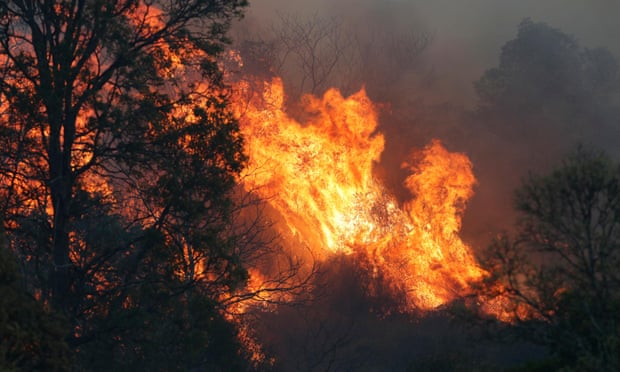
Does climate change cause bushfires?
The link between rising greenhouse gas emissions and increased bushfire risk is complex but, according to major science agencies, clear. Climate change does not create bushfires, but it can and does make them worse. A number of factors contribute to bushfire risk, including temperature, fuel load, dryness, wind speed and humidity.
What is the evidence on rising temperatures?
The Bureau of Meteorology and the CSIRO say Australia has warmed by 1C since 1910 and temperatures will increase in the future. The Intergovernmental Panel on Climate Change says it is extremely likely increased atmospheric concentrations of greenhouse gases since the mid-20th century is the main reason it is getting hotter. The Bushfire and Natural Hazards research centre says the variability of normal events sits on top of that. Warmer weather increases the number of days each year on which there is high or extreme bushfire risk.
What other effects do carbon emissions have?
Dry fuel load - the amount of forest and scrub available to burn - has been linked to rising emissions. Under the right conditions, carbon dioxide acts as a kind of fertiliser that increases plant growth.
So is climate change making everything dryer?
Dryness is more complicated. Complex computer models have not found a consistent climate change signal linked to rising CO2 in the decline in rain that has produced the current eastern Australian drought. But higher temperatures accelerate evaporation. They also extend the growing season for vegetation in many regions, leading to greater transpiration (the process by which water is drawn from the soil and evaporated from plant leaves and flowers). The result is that soils, vegetation and the air may be drier than they would have been with the same amount of rainfall in the past.
What do recent weather patterns show?
The year coming into the 2019-20 summer has been unusually warm and dry for large parts of Australia. Above average temperatures now occur most years and 2019 has been the fifth driest start to the year on record, and the driest since 1970.
Is arson a factor in this year's extreme bushfires?
Not a significant one. Two pieces of disinformation, that an “arson emergency”, rather than climate change, is behind the bushfires, and that “greenies” are preventing firefighters from reducing fuel loads in the Australian bush have spread across social media. They have found their way into major news outlets, the mouths of government MPs, and across the globe to Donald Trump Jr and prominent right-wing conspiracy theorists.
NSW’s Rural Fire Service has said the major cause of ignition during the crisis has been dry lightning. Victoria police say they do not believe arson had a role in any of the destructive fires this summer. The RFS has also contradicted claims that environmentalists have been holding up hazard reduction work.
His deputy prime minister, Michael McCormack, from the country-based Nationals party, said concerns over climate change while fires were burning were a “disgrace”.
“They don’t need the ravings of some pure, enlightened and woke capital city greenies at this time.”
But critics – some of whom had lost homes in the fires – argued the fires presented the reality of the impact of the climate crisis.
As Morrison visited a fire command site in northern NSW, a protester heckled: “Climate change is real. Can’t you see?” before he was escorted out of the building.
The opposition Labor party has also been condemned over its climate policies. In the wake of a general election defeat this year, it appears set to soften the 45% emissions reduction target that was party policy.
The opposition leader, Anthony Albanese, was confronted by by Ginger O’Brien, a resident of Nimbin, a famed counter-culture retreat on the north coast of NSW, who told him: “Shame on you.”
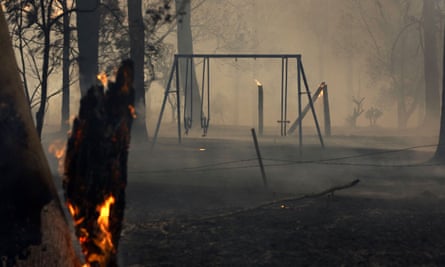
“Your house is not burning. My house is burning down,” an incensed O’Brien said. “What are you doing? Nothing. You’re laughing. You’re having a circus. You’re playing with fire.”

Fitzsimmons said for days ahead there would be more dangerous weather, as hot, dry and windy conditions returned. Friday, Saturday and Sunday are predicted to be extreme – though not catastrophic – weather conditions.
“We can expect to see elevated fire dangers again. I don’t have anything to suggest catastrophic at this stage, but severe and above is likely,” he said.
In one of the largest peacetime mobilisations of Australian forces, the defence minister, Linda Reynolds, is preparing to send army, navy and air force reserve forces – the equivalent of the UK’s Army Reserve – into the fire zone to assist with evacuations and logistics.
The military intervention might even include an unprecedented compulsory call-up of reserve forces, such is the scale of the fire damage.
